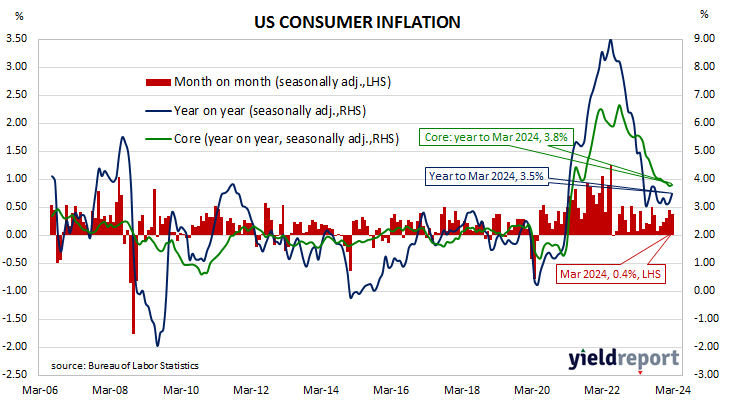Summary: US CPI up 0.4% in March, greater than expected; annual inflation rate rises from 3.2% to 3.5%; “core” rate also up 0.4%, up 3.9% over year; ANZ: improvement in CPI has stalled; Treasury yields jump; rate-cut expectations soften significantly; ANZ: data shows outsized price gains concentrated in few categories; prices of non-energy services main driver again.
The annual rate of US inflation as measured by changes in the consumer price index (CPI) halved from nearly 3% in the period from July 2018 to February 2019. It then fluctuated in a range from 1.5% to 2.0% through 2019 before rising above 2.0% in the final months of that year. Substantially lower rates were reported from March 2020 to May 2020 and they remained below 2% until March 2021. Rates then rose significantly before declining from mid-2022.
The latest US CPI figures released by the Bureau of Labor Statistics indicated seasonally-adjusted consumer prices rose by 0.4% on average in March. The increase was greater than the 0.4% which had been generally expected but in line with February’s rise. On a 12-month basis, the inflation rate accelerated from 3.2% to 3.5%.
“Headline” inflation is known to be volatile and so references are often made to “core” inflation for analytical purposes. The core prices index, the index which excludes the more variable food and energy components, also increased by 0.4% on a seasonally-adjusted basis over the month, above consensus expectations of a 0.3% rise. However, the annual growth rate still slowed from February revised rate of 4.0% to 3.9%.
“The 0.4% month-on-month rise in March headline and core CPI data disappointed as it signalled the improvement in that measure of inflation has stalled,” said ANZ Head of G3 Economics Brian Martin.
US Treasury bond yields jumped on the day, especially at the short end of the curve. By the close of business, the 2-year Treasury yield had gained 23bps to 4.97%, the 10-year yield had added 19bps to 4.55% while the 30-year yield finished 14bps higher at 4.63%.
In terms of US Fed policy, expectations of a lower federal funds rate in the next 12 months softened significantly, although two cuts are still currently factored in. At the close of business, contracts implied the effective federal funds rate would average 5.32% in May, 1bp less than the current spot rate, 5.30% in June and 5.28% in July. However, April 2025 contracts implied 4.72%, 51bps less than the current rate.
“However, scrutiny of the data shows outsized price gains are concentrated in a few categories, like medical insurance, vet services and motor insurance and repair,” Martin added. “Elsewhere, core goods inflation fell, shelter inflation continued to moderate and many key service sectors like recreation, financial services, education, communications and other personal services showed much more normalised price changes.”
The largest influence on headline results is often the change in fuel prices. Prices of “Energy commodities”, the segment which contains vehicle fuels, increased by 1.5% and contributed 0.05 percentage points to the total. However, prices of non-energy services, the segment which includes actual and implied rents, again had the largest effect on the total, adding 0.30 percentage points after increasing by 0.5% on average.



